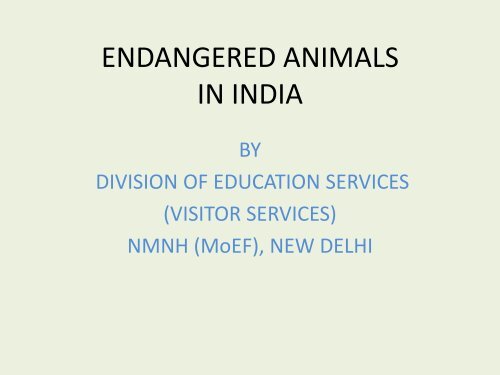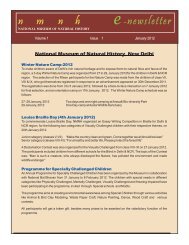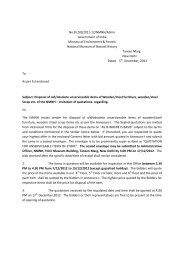endangered animals in india - National Museum of Natural History
endangered animals in india - National Museum of Natural History
endangered animals in india - National Museum of Natural History
You also want an ePaper? Increase the reach of your titles
YUMPU automatically turns print PDFs into web optimized ePapers that Google loves.
ENDANGERED ANIMALS<br />
IN INDIA<br />
BY<br />
DIVISION OF EDUCATION SERVICES<br />
(VISITOR SERVICES)<br />
NMNH (MoEF), NEW DELHI
ENDANGERED ANIMALS<br />
IN INDIA<br />
• Critically Endangered species <strong>in</strong> India Accord<strong>in</strong>g to the Red Data Book <strong>of</strong><br />
International Union for Conservation <strong>of</strong> Nature (IUCN), there are 47<br />
critically <strong>endangered</strong> species <strong>in</strong> India (As <strong>of</strong> 5 September 2011 (2011-09-<br />
05)<br />
• The Red list <strong>of</strong> 2012 is out on 18 february 2012 at Rio +20 Earth Summit.<br />
Red List has listed 132 species <strong>of</strong> plants and <strong>animals</strong> as Critically<br />
Endangered from India.
Indian Bustard- Ardeotis nigriceps<br />
(Vigors)Great
• The Great Indian Bustard (Ardeotis nigriceps) or<br />
Indian Bustard is a bustard found <strong>in</strong> India and the<br />
adjo<strong>in</strong><strong>in</strong>g regions <strong>of</strong> Pakistan. A large bird with a<br />
horizontal body and long bare legs giv<strong>in</strong>g it an ostrich<br />
like appearance, this bird is among the heaviest <strong>of</strong> the<br />
fly<strong>in</strong>g birds. The deep buff coloured w<strong>in</strong>gs with black<br />
sides, a conspicuous black crested crown, an<br />
outstretched neck which is whitish <strong>in</strong> colour and the<br />
white underparts are the dist<strong>in</strong>guish<strong>in</strong>g featutes <strong>of</strong><br />
this bird. Once common on the dry pla<strong>in</strong>s <strong>of</strong> the<br />
Indian subcont<strong>in</strong>ent, today very few birds survive and<br />
the species is on the br<strong>in</strong>k <strong>of</strong> ext<strong>in</strong>ction, be<strong>in</strong>g<br />
critically <strong>endangered</strong> by hunt<strong>in</strong>g and loss <strong>of</strong> its<br />
habitat, this consists <strong>of</strong> large expanses <strong>of</strong> dry<br />
grassland and scrub. They are conf<strong>in</strong>ed mostly to the<br />
arid regions <strong>of</strong> Rajasthan, Gujarat and the<br />
Ahmednagar district <strong>of</strong> Maharashtra.
Jerdon;s Courser ( Cursorious bitorquatus<br />
( Blyth)
• Jerdon's Courser is one <strong>of</strong> the rarest birds <strong>of</strong> the world. It is<br />
listed as Critically Endangered by IUCN. Because it known<br />
only from one s<strong>in</strong>gle site and the habitat <strong>in</strong> which it lives is<br />
also shr<strong>in</strong>k<strong>in</strong>g and degrad<strong>in</strong>g.<br />
•<br />
• It is a nocturnal bird endemic to India. The bird was<br />
discovered by the surgeon-naturalist Thomas C. Jerdon <strong>in</strong><br />
1848 but not seen aga<strong>in</strong> until its rediscovery <strong>in</strong> 1986 by<br />
Bombay <strong>Natural</strong> <strong>History</strong> Society from Godavary river valley<br />
<strong>in</strong> Andhra Pradesh. This courser is a restricted-range<br />
endemic found locally <strong>in</strong> India <strong>in</strong> Anantpur, Cuddapah,<br />
Nellore and Bhadrachalam <strong>in</strong> the Godavary valley <strong>in</strong> the<br />
Eastern Ghats <strong>of</strong> Andhra Pradesh.<br />
•<br />
• The bird has a p<strong>in</strong>kish, sandy brown plumage with a dark<br />
brown crest and a broad, white supercilium loop<strong>in</strong>g around<br />
the nape. The ch<strong>in</strong> and throat are whitish and the abdomen<br />
is grayish white <strong>in</strong> colour. The tail is white with black.
Himalayan Monal, Pheasant - Lophophorus<br />
impejanus (Latham)<br />
MALE<br />
FEMALE
• The Himalayan Monal secures a dist<strong>in</strong>ct position among pheasants<br />
due to its prom<strong>in</strong>ent build, brilliant plumage and strong<br />
association with local folklore. Its natural range spreads from<br />
eastern Afghanistan through the Himalayas <strong>in</strong>clud<strong>in</strong>g Kashmir<br />
region <strong>of</strong> Northern Pakistan, India (states <strong>of</strong> Himachal Pradesh,<br />
Uttarakhand, Sikkim and Arunachal Pradesh), Nepal, southern<br />
Tibet and Bhutan. There is also a report <strong>of</strong> its occurrence <strong>in</strong><br />
Burma. It occupies upper temperate oak-conifer forests<br />
<strong>in</strong>terspersed with open grassy slopes, cliffs and alp<strong>in</strong>e meadows<br />
between 2400 – 4500m, mostly concentrat<strong>in</strong>g <strong>in</strong> a narrow belt <strong>of</strong><br />
2700 – 3700m. They seem to exhibit clear and fluctuat<strong>in</strong>g<br />
altitud<strong>in</strong>al migration reach<strong>in</strong>g as low as 2000m <strong>in</strong> w<strong>in</strong>ter. They,<br />
however, show tolerance to snow and have been observed to dig<br />
through snow for roots, tubers and other plant parts, and<br />
<strong>in</strong>vertebrates. Seen <strong>in</strong> pairs dur<strong>in</strong>g the breed<strong>in</strong>g season (April to<br />
August), they form large coveys and <strong>in</strong>volve <strong>in</strong> communal roost<strong>in</strong>g<br />
dur<strong>in</strong>g the w<strong>in</strong>ter. The population <strong>of</strong> this species <strong>in</strong> most <strong>of</strong> its<br />
range is threatened due to poach<strong>in</strong>g and other anthropogenic<br />
factors. In a recent study, their population responded negatively<br />
to human disturbance (Hydro-electric project development) [3] The<br />
male monal has been under heavy hunt<strong>in</strong>g pressure for its crest<br />
feather, which was used for ornamental hats <strong>of</strong> Himachal men,<br />
until 1982 when legal hunt<strong>in</strong>g was banned <strong>in</strong> the state.
Sarus Crane (Grus antigone antigone )
• The Sarus Crane is a large non-migratory crane found <strong>in</strong> parts<br />
<strong>of</strong> the Indian Subcont<strong>in</strong>ent, Southeast Asia and Australia. The<br />
tallest <strong>of</strong> the fly<strong>in</strong>g birds, stand<strong>in</strong>g at a height <strong>of</strong> up to 1.8 m<br />
(5.9 ft) they are conspicuous species <strong>of</strong> open wetlands. The<br />
Sarus Crane is easily dist<strong>in</strong>guished from other cranes <strong>in</strong> the<br />
region by the overall grey colour and the contrast<strong>in</strong>g red head<br />
and upper neck. They forage on marshes and shallow<br />
wetlands for roots, tubers, <strong>in</strong>sects, crustaceans and small<br />
vertebrate prey. Like other cranes, they form long-last<strong>in</strong>g pairbonds<br />
and ma<strong>in</strong>ta<strong>in</strong> territories with<strong>in</strong> which they perform<br />
territorial and courtship displays that <strong>in</strong>clude loud<br />
trumpet<strong>in</strong>g, leaps and dance-like movements.<br />
• Sarus Crane numbers have decl<strong>in</strong>ed greatly <strong>in</strong> the last century<br />
and it has been estimated that the current population is a<br />
tenth or less (perhaps 2.5%) <strong>of</strong> the numbers that existed <strong>in</strong><br />
the 1850s. The stronghold <strong>of</strong> the species is India, where it is<br />
traditionally revered and lives <strong>in</strong> agricultural lands <strong>in</strong> close<br />
proximity to humans. Elsewhere, the species has been<br />
extirpated <strong>in</strong> many parts <strong>of</strong> its former range.
Asiatic lion- Panthera leo persica (Meyer)
• The Asiatic lion also known as babbar sher <strong>in</strong> h<strong>in</strong>di. The<br />
only place <strong>in</strong> the wild where this species is found is <strong>in</strong><br />
the Gir Forest <strong>in</strong> Kathiawar <strong>of</strong> Gujarat, India. The Asiatic<br />
lion is one <strong>of</strong> the five major big cats found <strong>in</strong> India, the<br />
others be<strong>in</strong>g the Bengal tiger, the Indian leopard, the<br />
snow leopard and leopard. They prey ma<strong>in</strong>ly on cattle,<br />
deer, pig and other herbivore by mak<strong>in</strong>g a short, high –<br />
speed charge upto 80 km per hour.<br />
• The Asiatic lions once ranged from the Mediterranean<br />
to the northeastern parts <strong>of</strong> the Indian subcont<strong>in</strong>ent,<br />
but excessive hunt<strong>in</strong>g, habitat destruction, decl<strong>in</strong>e <strong>in</strong><br />
natural prey and human <strong>in</strong>terference have reduced<br />
their number. This forest is the last refuge <strong>of</strong> the Asiatic<br />
lion <strong>in</strong> the world, other than those protected <strong>in</strong> various<br />
zoos.
Blackbuck - Antilope cervicapra (L<strong>in</strong>naeus)
• The blackbuck (Antilope cervicapra) is an antelope<br />
species native to the Indian Subcont<strong>in</strong>ent that has<br />
been classified as <strong>endangered</strong> by IUCN s<strong>in</strong>ce 2003, as<br />
the blackbuck range has decreased sharply dur<strong>in</strong>g the<br />
20th century. Males and females have dist<strong>in</strong>ctive<br />
coloration. Male blackbucks are dark brown, black,<br />
and white and have long, twisted horns, while<br />
females are fawn-coloured with no horns. Blackbucks<br />
orig<strong>in</strong>ally ranged over large tracts <strong>of</strong> India except <strong>in</strong><br />
the northeast. Today, the blackbuck population is<br />
conf<strong>in</strong>ed to areas <strong>in</strong> Maharashtra, Orissa, Punjab,<br />
Rajasthan, Haryana, Gujarat, Andhra Pradesh, Tamil<br />
Nadu and Karnataka, with a few small pockets <strong>in</strong><br />
central India. The ma<strong>in</strong> threats to the species are<br />
poach<strong>in</strong>g, predation, habitat destruction, overgraz<strong>in</strong>g,<br />
diseases, <strong>in</strong>breed<strong>in</strong>g and sanctuary visitors.
Ganges River Dolph<strong>in</strong> - Platanista gangetica
• As an <strong>in</strong>dicator <strong>of</strong> the health <strong>of</strong> the freshwater<br />
ecosystem, the Ganges River Dolph<strong>in</strong> has recently<br />
been recognized by the government <strong>of</strong> India as its<br />
<strong>National</strong> Aquatic Animal.<br />
While habitat loss and pollution <strong>of</strong> fresh water<br />
aquatic systems are a major threat to this species,<br />
there are also reports that this animal is be<strong>in</strong>g killed<br />
and traded for its body parts, especially fat and oil.<br />
•<br />
Ganges River Dolph<strong>in</strong> is listed on the Appendix I <strong>of</strong><br />
CITES (Convention on International Trade <strong>in</strong><br />
Endangered Species <strong>of</strong> Wild Fauna and Flora) and<br />
Schedule I <strong>of</strong> India’s Wildlife (Protection), Act, 1972.<br />
Therefore, hunt<strong>in</strong>g <strong>of</strong> the species and both domestic<br />
and <strong>in</strong>ternational trade <strong>in</strong> the species and its parts<br />
and derivatives is completely prohibited.
Hoolock Gibbon (Hylobates hoolock)
• Hoolock Gibbon is the only ape to be found<br />
<strong>in</strong> India. It is the most accomplished acrobat<br />
<strong>of</strong> all the apes. It lives <strong>in</strong> dense forests <strong>of</strong><br />
north - eastern India. It is found <strong>in</strong><br />
Bangladesh and <strong>in</strong> some parts <strong>of</strong> Burma and<br />
Ch<strong>in</strong>a. Its range extends <strong>in</strong>to seven states<br />
cover<strong>in</strong>g Arunachal Pradesh, Assam,<br />
Manipur, Meghalaya, Mizoram, Nagaland and<br />
Tripura.
Nilgiri langur (Presbytis johni)
• The Nilgiri langur (Trachypithecus johnii) is<br />
found <strong>in</strong> the Nilgiri Hills <strong>of</strong> the Western Ghats <strong>in</strong><br />
South India. Its range also <strong>in</strong>cludes Kodagu <strong>in</strong><br />
Karnataka, Kodayar Hills <strong>in</strong> Tamil Nadu and<br />
many other hilly areas <strong>in</strong> Kerala and Tamil Nadu.<br />
This primate has glossy black fur on its body and<br />
golden brown fur on its head. It is similar <strong>in</strong> size<br />
and long tailed like the gray langurs. Females<br />
have a white patch <strong>of</strong> fur on the <strong>in</strong>ner thigh. It<br />
lives <strong>in</strong> troops <strong>of</strong> five to 16 monkeys. The animal<br />
is <strong>of</strong>ten seen encroach<strong>in</strong>g <strong>in</strong>to agricultural lands.<br />
It’s diet consists <strong>of</strong> fruits, shoots and leaves. The<br />
species is <strong>endangered</strong> due to deforestation and<br />
poach<strong>in</strong>g for its fur and flesh, the latter believed<br />
to have aphrodisiac properties.
Wild Ass (Equus hemionus khur)
• The Indian wild ass's range once extended<br />
from western India, southern Pakistan (i.e.<br />
prov<strong>in</strong>ces <strong>of</strong> S<strong>in</strong>dh and Baluchistan),<br />
Afghanistan, and south-eastern Iran. Today,<br />
its last refuge lies <strong>in</strong> the Indian Wild Ass<br />
Sanctuary, Little Rann <strong>of</strong> Kutch and its<br />
surround<strong>in</strong>g areas <strong>of</strong> the Great Rann <strong>of</strong> Kutch<br />
<strong>in</strong> the Gujarat prov<strong>in</strong>ce <strong>of</strong> India. The animal,<br />
however, is also seen <strong>in</strong> the districts <strong>of</strong><br />
Surendranagar, Banaskantha, Mehsana, and<br />
other Kutch districts. Sal<strong>in</strong>e deserts (rann),<br />
arid grasslands and shrublands are its<br />
preferred environments.
Lion Tailed Macaque - Macaca<br />
silenus(L<strong>in</strong>naeus)
• The lion-tailed macaque (Macaca silenus) is<br />
endemic to the Western Ghats <strong>of</strong> South India.<br />
The hair <strong>of</strong> the lion-tailed macaque is black. Its<br />
outstand<strong>in</strong>g characteristic is the silver-white<br />
mane which surrounds the head from the<br />
cheeks down to its ch<strong>in</strong>. The hairless face is<br />
black <strong>in</strong> color. With a head-body length <strong>of</strong> 42 to<br />
61 cm and a weight <strong>of</strong> 2 to 10 kg, it ranks among<br />
the smaller macaques. The tail is medium <strong>in</strong><br />
length, and has a black tuft at the end, similar<br />
to a lion's tail. The male's tail-tuft is more<br />
developed than that <strong>of</strong> the female. It primarily<br />
eat <strong>in</strong>digenous fruits, leaves, buds, <strong>in</strong>sects and<br />
small vertebrates <strong>in</strong> virg<strong>in</strong> forest.
Olive Ridley Sea Turtle - Lepidochelys olivacea
• These turtles are solitary, preferr<strong>in</strong>g the open<br />
ocean. They migrate hundreds or even<br />
thousands <strong>of</strong> miles every year, and come<br />
together as a group only once a year when<br />
females return to the beaches where they<br />
hatched and lumber onshore, sometimes <strong>in</strong><br />
the thousands, to nest. In the India Ocean,<br />
the majority <strong>of</strong> olive ridleys nest <strong>in</strong> two or<br />
three large bundles near Gahirmatha <strong>in</strong> the<br />
Orissa. However, olive ridleys are considered<br />
a rarity <strong>in</strong> most areas <strong>of</strong> the Indian Ocean
The Indian pangol<strong>in</strong> - Manis crassicaudata<br />
(Gray)
• It has large, overlapp<strong>in</strong>g scales on the body<br />
which act as armour. The massive, scaled<br />
armour <strong>of</strong> this animal, which covers its upper<br />
face and its whole body, does not cover the<br />
belly and <strong>in</strong>ner side <strong>of</strong> the legs. It can also<br />
curl itself <strong>in</strong>to a ball as self-defense aga<strong>in</strong>st<br />
predators such as the tiger. The colour <strong>of</strong> its<br />
scales varies depend<strong>in</strong>g on the colour <strong>of</strong> the<br />
earth <strong>in</strong> its surround<strong>in</strong>gs. It is an <strong>in</strong>sectivore<br />
that feeds on ants and termites, digg<strong>in</strong>g them<br />
out <strong>of</strong> mounds and logs us<strong>in</strong>g its long claws,<br />
which are as long as its forelimbs.
The Nilgiri tahr (Nilgiritragus hylocrius)
• The Nilgiri tahr, Nilgiritragus hylocrius, known<br />
locally as the Nilgiri ibex or simply ibex, is<br />
an ungulate that is endemic to the Nilgiri<br />
Hills and the southern portion <strong>of</strong> theWestern<br />
Ghats <strong>in</strong> the states <strong>of</strong> Tamil Nadu and Kerala <strong>in</strong><br />
southern India. It is the state animal <strong>of</strong> Tamil<br />
Nadu.<br />
• The Nilgiri tahrs are stocky goats with short,<br />
coarse fur and a bristly mane. Males are larger<br />
than the females, and have a darker color when<br />
mature. Both sexes have curved horns, which<br />
are larger <strong>in</strong> the males, Adult males develop a<br />
light grey area on their backs and are thus called<br />
"saddlebacks".
The leopard cat (Prionailurus bengalensis)
• The leopard cat is a small wild<br />
cat <strong>of</strong> South and East Asia. S<strong>in</strong>ce 2002 it has<br />
been listed as Least Concern by IUCN as it is<br />
widely distributed but threatened by habitat<br />
loss and hunt<strong>in</strong>g <strong>in</strong> parts <strong>of</strong> its range. The<br />
leopard cat's name is derived from the leopardlike<br />
spots prevalent <strong>in</strong> all subspecies, but its<br />
relation to the leopard is distant.<br />
• They are found <strong>in</strong> agriculturally used areas but<br />
prefer forested habitats. They live <strong>in</strong> tropical<br />
evergreen ra<strong>in</strong>forests and plantations at sea<br />
level, <strong>in</strong> subtropical deciduous and coniferous<br />
forests <strong>in</strong> the foothills <strong>of</strong> the Himalayas. Leopard<br />
cats are solitary, except dur<strong>in</strong>g breed<strong>in</strong>g season.
THANKYOU

















